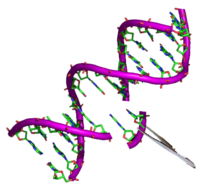
Photo from wikipedia
The development of herbicide-resistant germplasm is significant in solving the increasingly severe weed problem in crop fields. In this study, we, for the first time, rationally designed a predictable and… Click to show full abstract
The development of herbicide-resistant germplasm is significant in solving the increasingly severe weed problem in crop fields. In this study, we, for the first time, rationally designed a predictable and effective approach to create herbicide-resistant germplasm by combining mutation-dependent biomacromolecular quantitative structure-activity relationship (MB-QSAR) and CRISPR/Cas9-mediated base-editing strategies. Our results showed that the homozygous P197F-G654D-G655S or P197F-G654N-G655S Arabidopsis plants exhibited high resistance to multiple acetohydroxyacid synthase-inhibiting herbicides, including chlorsulfuron, bispyribac-sodium, and flucarbazone-sodium. Additionally, the plants with the homozygous P197S mutant displayed increased susceptibility to bispyribac-sodium than the wild-type but more resistance to flumetsulam than other mutants. Besides, we found that the herbicide resistance levels of the gene-edited plants have a good correlation with MB-QSAR prediction.
Journal Title: Journal of agricultural and food chemistry
Year Published: 2022
Link to full text (if available)
Share on Social Media: Sign Up to like & get
recommendations!